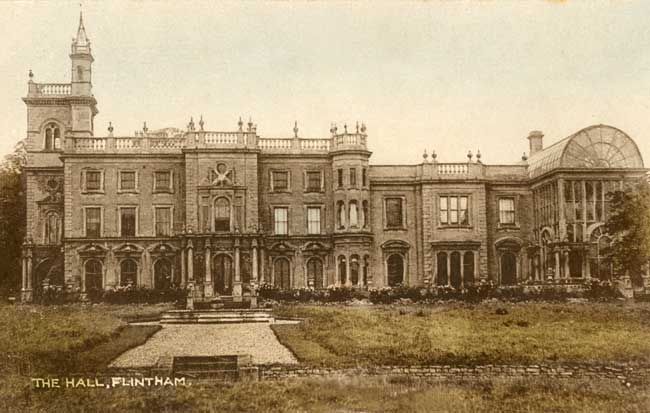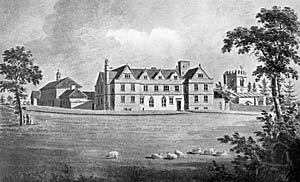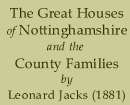< Colston Bassett | Contents | Grove >
Flintham

Flintham Hall in the 1920s.
FLINTHAM Hall stands just far enough from the old Fosse Road to be removed from the sound of the occasional, and that mostly rustic, traffic, which passes along that broad, continuous highway, still one of the best in the county, after many centuries of wear. There was a populous, and not unprosperous, village of Flintham, which numbered amongst its population the inmates of a great house, long before the present mansion was built. The stones of which its imposing walls are composed, and whose bright, fresh colour may almost be taken as suggestive of the purity of the air which is blown from the surrounding hills, were unquarried when the Husseys, Hackers, and Fletchers had a seat at Flintham, and were of the county families. It is not half a century old yet, having been built by the late Colonel Hildyard, doubtless at a very great cost, and with a determination to make it one of the leading houses in the county. On the Fosse Road, midway between Bingham and Newark, you come to a lodge which overlooks a winding gravel walk and an ornamental plantation. Before spring has set in, and while the wild winds of March sweep through the leafless branches of the lofty park trees, there are white patches upon the turf, and they look like the remains of a lingering winter. They are natural beds of snowdrops, which grow here in chaste and unchecked luxuriance. On either side of the drive there are some stately specimens of auricaria imbricala and cedrus deodara, the former of which have had a hard fight for it during the winter. The auricarias with their writhing arms, which seem to have been struck motionless just as they were in the act of making some fantastic curve, arc in their proper place along a broad carriage drive.
The entrance to the hall is under the tower, and you do not get an adequate idea of the extent of the building upon first acquaintance. Its proportions are best seen from the park or the gardens. The external appearance of the house suggests the possession of elegant apartments. There is one room at Flintham which is much handsomer than any of the rest, and fulfils every purpose for which the principal apartment in a great house is designed. It is now used as a drawing room, but if one called it the library, or the central hall, or the saloon, no grave error would be committed. At one end of this large and well-apportioned room, is a smaller apartment, which is separated by a kind of screen supported by marble pillars; at the other is a conservatory, lofty, cool, and well filled with plants, an arrangement which is no less artistic than convenient. This conservatory, though small as regards the area it covers, has been carried up to a considerable height and fitted with great taste. It is ornamented with mirrors; there is a fountain of white marble placed opposite to the room by way of which you enter this miniature crystal palace, and at intervals there appear brackets upon which are placed small marble figures of nymphs and goddesses. The gas burners—gas is made on the premises—are the stamens of so many white lilies, the lips of which are of marble. In the upper part of the principal room, of which the conservatory may almost be described as a continuation, is a gallery, which is reached by a small spiral staircase, and from which one may more closely inspect the richly decorated ceiling. On one side of the gallery is placed a range of bookshelves, well stocked with a miscellaneous collection of literature, part of which belongs to the owner of the mansion and part to his tenant. On the other side is a range of plate glass, distributed in the form or windows, in the midst of which is a kind of alcove or recess with easy chair and table. This is a favourite place with most people who visit Flintham, and who wish to be alone. It commands a full and uninterrupted view of one of the brightest and most cheerful prospects in the county.

Flintham Hall in 1778.
Flintham hall occupies a somewhat elevated site in the midst of a landscape which is not hilly. The country about is generally flat and of a decidedly pastoral description, but the park supplies a cheerful expanse of scenery, broken and diversified by a somewhat scattered sylvan growth, and acquiring an added variety by the presence of a small lake, in the middle of which is a pretty summerhouse, built upon a little island. In the park alone, which is some two hundred and fifty acres in extent, there is much to please the eyes of those who happen to look out of the windows, whether of the gallery or the ground floor, in the full light of midday, or when the sinking sun is reddening the surface of the lake. There is in this handsome saloon, which I will call the library, a singularly fine projecting mantelpiece of carved wood. This was purchased by Mr. Hildyard at one of the exhibitions, and it is said that a desire to have so handsome a piece of furniture set off to the best advantage, prompted the owner to build this superb apartment, in which the proportions of the mantelpiece are now effectively displayed. On either side of the fireplace a large picture is hung. Those who are familiar with the best known examples of Snyders art, will recognise that master in the library. The picture represents an affray between dogs and foxes (not, I think, a common kind of warfare, that is, when waged by three foxes against twice the number of dogs), in which the dogs appear to be getting the worst of it.
The dining room contains the bulk of the pictures—chiefly family portraits of the Hildyards and Thorotons (the late Colonel Hildyard was a Thoroton before he married Miss White, the heiress). Dr. Thoroton, the historian and antiquarian, was one of the family, and his portrait is among the dining room collection. Sir Robert Hildyard, of whom more hereafter, sat in his early days to Sir Joshua Reynolds, and later to Sir Thomas Lawrence, and the results are at present preserved on canvas in the dining room at Flintham together with several of the Darcys, who were collaterally related. Coyp and Ruysdael are both represented on the rooms of this beautiful residence, and there are two good examples of the art of Philip Mercier, and one of that of a celebrated Dutchman—"The Prodigal Son." The portraits in the drawing room are let into the panelling, which completely pervades the wall, with such nicety, that they look like little panel pictures. They are mostly the portraits of Mr. Hildyard’s ancestors—the members of a family, one of whom, as commander for the Lancastrians, beat off the Yorkists, at Towton, held the bridge, and was distinguished for his general bravery. Occupying a prominent position amongst this family group, is a portrait of Mr. Thomas Blackborne Thoroton Hildyard, who has represented the southern division of this county for many years, and is as fine a specimen of an English country gentleman as you would meet with in a day’s march. The picture over the mantelpiece, evidently painted some years ago, gives, I think, an imperfect idea of Mr. Hildyard’s presence, when, ten years ago, it was more familiar in the district than now.
< Colston Bassett | Contents | Grove >
